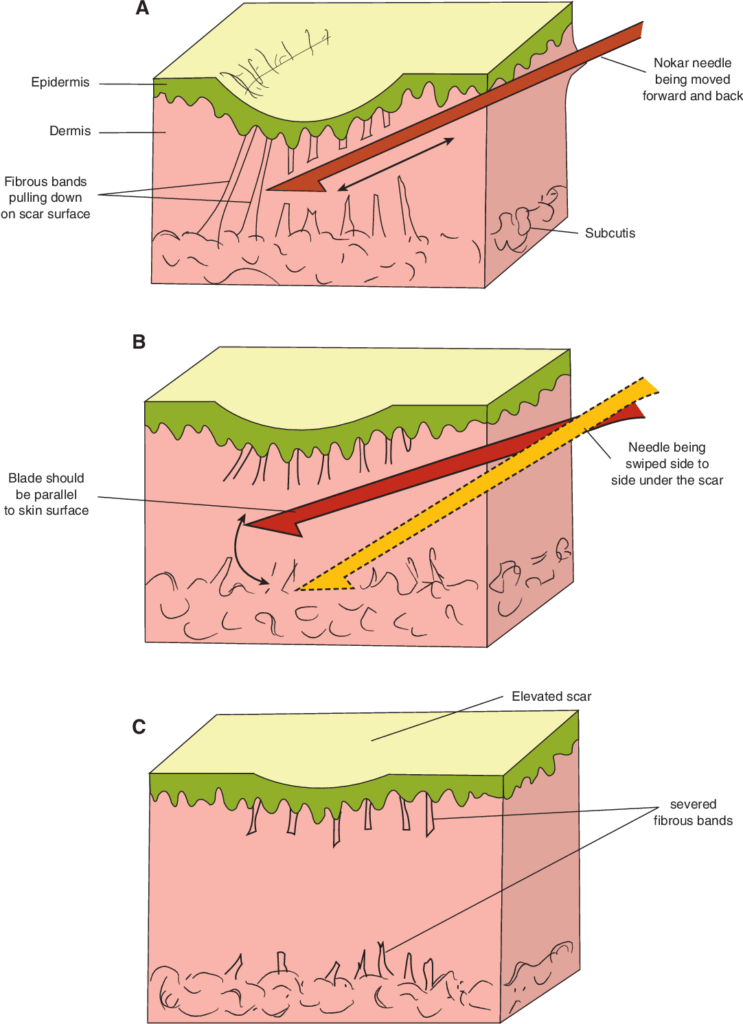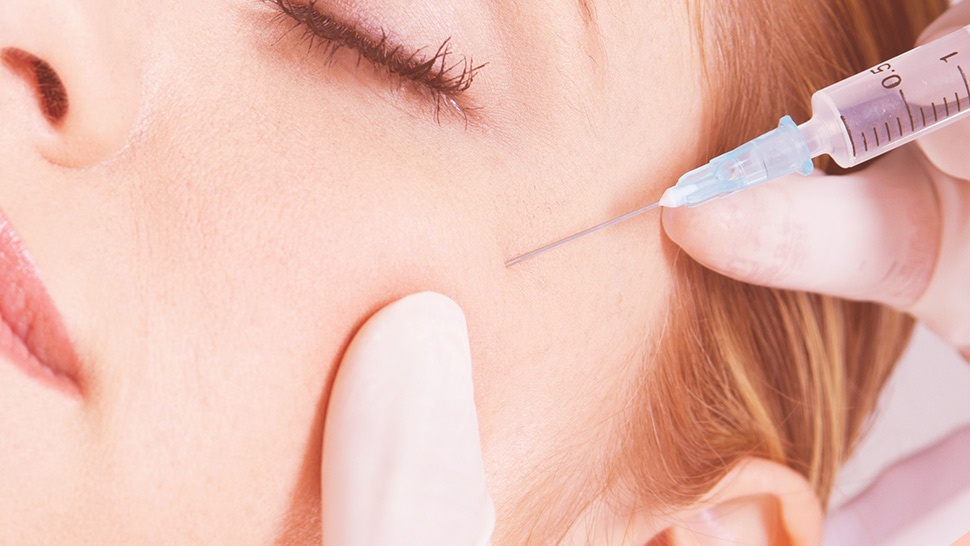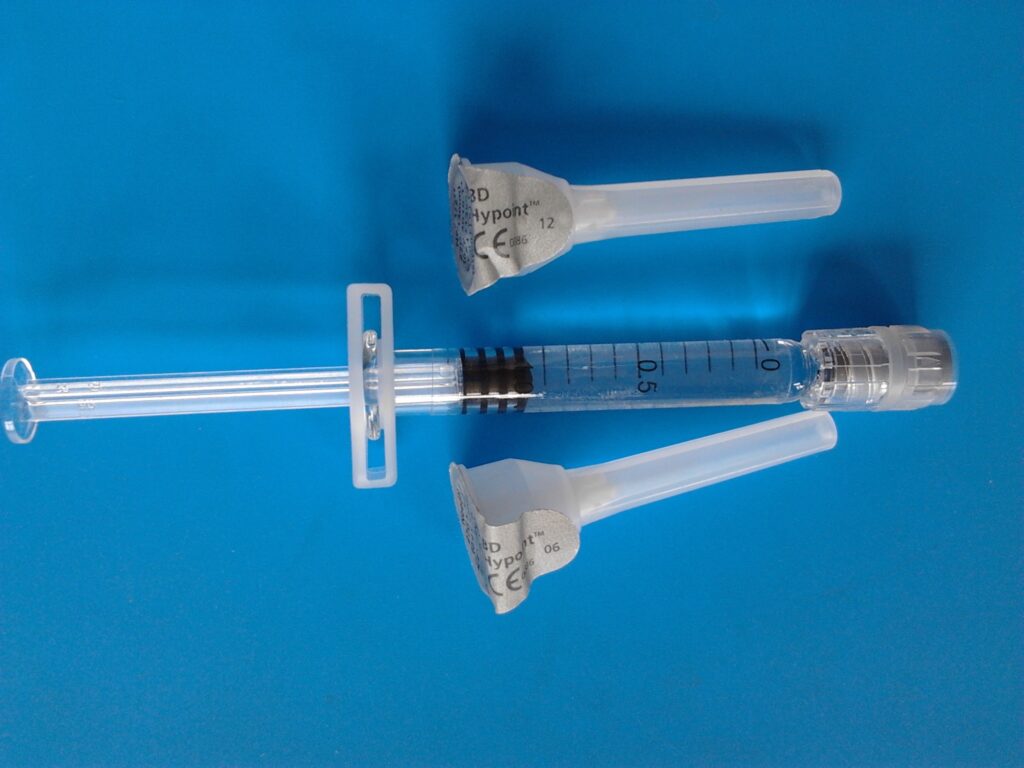Treatment of Acne scars with subcision

By Ulrik knap, md, laser & acne scar specialist
Treating acne scars is a medical art that requires great skills and the use of the right methods. Not one method fits all acne scar types. Hence, I treat acne scars with different methods and choose the best methods for each individual acne scar. Combining different methods – when relevant – is the only way to achieve the highest cure rate. Therefore, patients come from most of the world to visit my office and have their acne scars treated by me personally.
what is subcision?
One of the methods I use is subcision which remains one of the most effective treatments for tethered, rolling, anchored and bound down acne scars.
Basically, those acne scars adhere to deeper structures such as the fat tissue and even the surface of muscles. This occurs when the inflammation – caused by acne – is deep enough to involve both the skin and the structures underneath the skin. Afterward, when the skin heals, massive uncontrolled production of collagen occurs in all layers of the skin all the way down into the facial fat, causing the scar to depress. Hence, now we have a tethered or anchored acne scar.
In those types of acne scars, the tethering needs to be broken down. This is done horizontally with a sharp needle, and not vertically with a laser or a Dermapen.
The principle of subcision is illustrated in the figure.


WHAT ACNE SCAR TYPES CAN BE TREATED WITH SUBCISION?
Acne scars can be divided into different acne scar types including ice pick scars, boxcar scars, rolling scars, deep atrophic scars, hypertrophic scars, red scars, tethered scars, and anchored scars.
Tethered and anchored scars are pulled down by fibrotic bands that bind to underlying structures such as the fat tissue or to the surface of a muscle.
Those acne scars can be identified by having the patient smiling and animating. Likewise, if the scar remains depressed while stretching out the skin, the scar is probably tethered, and are likely to improve with subcision.

How do I know that subcision is the best treatment for my acne scars?
When I examine acne scars, I use my years of experience to identify the different acne scar types. Identifying the right acne scar types and matching them with the correct methods gives the highest cure rate.
Identifying tethered and anchored acne scars, I have the patient smile and animate, and I stretch the skin to look for any signs of tethering. This is a 3-dimensional examination that cannot be done by examining a photo or the patient via Skype. Therefore, I always see my patients for physical consultation.
A precise classification of the acne scars is important for my choice of treatment for individual acne scars.
Subcision is one of my treatments. This procedure is supreme to break down any scar tissue that might cause depression in a scar. This cannot be done with methods, such as fractional lasers, micro-needling, or chemical peels.
After the tethering is broken down, dermal filler is injected into the acne scar as a buffer and to replace any volume loss caused by the acne-related inflammation.

How do I perform subcision of acne scars?
When I have identified the right acne scar types, the patient and I select which acne scars should be treated. Mapping of the acne scars is performed. Treatment of the acne scars can then begin.
Subcision is performed on tethered, rolling scars, anchored scars and bound down scars.
First, I apply a local anesthetic agent to numb the area before treatment. Thereafter, I use a sharp needle to break down the scar tissue. In areas of the face where the skin is very fine, such as in the temple, I use a thin needle, while in areas where the skin is thicker and fibrotic bands might be more severe, I use a Nokor needle to break down the fibrotic bands. The result is seen immediately after the procedure.
To avoid that the acne scar creates new adherences to the underlying structures, I use a dermal filler to inject into the cavity underneath the scar. This works as a buffer; besides that, it replaces any volume loss caused by acne.
After the procedure, the patient has some ice on the treated area to limit any bleeding and swelling.
Does subcision give permanent results?
Yes! If the acne scar is tethered to underlying structures, breaking up the fibrotic bands will give an immediate and permanent lift of the scar.
If the acne scar has a substantial loss of tissue as well, you should know that it might be necessary to repeat the injection of dermal filler into the scar after some years because the dermal filler degrades with time. Meanwhile, subcision stimulates the skin to form new collagen fibers which gradually will compensate for the slow degradation of the dermal filler. This process happens over several months to years.
How much does my acne scars improve after subcision?
Subcision followed by dermal filler injections is one of the procedures that typically gives the most obvious and immediate improvement after treatment. However, it all depends on the individual scar, the severity of the acne scar, the amount of fibrosis, location of scar tissue, the thickness of the skin, and the patient.
In some cases, I achieve a 90-98% improvement in just one treatment, particularly in shallow acne scars with little or no volume loss. More severe atrophic scars with a lot of tethering can be harder to treat. These kinds of acne scars might require 2-3 treatments to achieve a 50-70% improvement when combined with a dermal filler.
What are the risks of subcision?
In skilled hands, subcision is a very safe technique with minimal risk of complications. Meanwhile, as with any other minor surgical procedure, there is always a risk of bruising, and infection. Small bleeding and bruising are difficult to avoid when treating larger acne scars which have a lot of tethering.
In very rare cases, granulomas can form under the skin after subcision. This can be treated with a small dosage of glucocorticoid injected directly into the lesion and should be done early on.
What precautions should I take after subcision?
Make sure to keep the skin clean with mild soap and water once daily. To avoid infection, please follow my instructions.
To minimize any bleeding or bruising please avoid any intake of dietary supplements, including garlic, fish oil, vitamins, etc., in the weeks prior to your treatment since many dietary supplements increase risk of bleeding.

After the treatment bruising, swelling and discomfort can be relieved by applying something cold from the freezer wrapped in a towel for 10 minutes every hour the first day. Pain is relieved by an additional supplement of painkillers over the counter in recommended dosages.
Always follow any oral and written instructions provided by me and my staff once you’re here.

What’re the benefits of subcision?
The best thing about subcision is that you’ll see immediate improvement after the procedure. Any adherence which causes the scar to depress is simply broken down. To see the full effect of the treatment, dermal filler should in many cases be injected beneath the scar after subcision to make sure that any volume loss is replaced and to avoid new adherences when the scar heals up after the procedure.
How much time does the procedure take?
Usually, the procedure doesn’t take me long; on average between 2-15 minutes. I can treat a single small shallow scar in only a few minutes, while larger atrophic scars with a lot of tethering and fibrotic bands take longer to treat.
How many treatments are required?
This depends on the type and severity of the acne scar. Shallow tethered acne scars typically only need one treatment, while in severe cases 2-3 treatments might be required.
Is it possible to combine subcision with other treatments?
Yes! As a general rule, subcision should be combined with dermal filler when treating atrophic acne scars with tissue loss. Besides the filler functions as a buffer underneath the acne scar and prevents the scar from making new adherences.
Ice pick scars can be treated in the same session but should be treated with other techniques such as TCA cross or – for very deep ice pick scars – punch excision.
The choice of methods is always based on a thorough analysis of the acne scars to identify the right acne scar types followed by choosing the best method for each individual acne scar.
I’ll always start by treating the deepest acne scars. Hence, having a patient with both boxcar scars, ice pick scars and tethered scars, I usually perform both TCA cross, subcision or tunneling with dermal filling, and/or punch excision for very deep scars. Eventually, when all the deepest acne scars have been raised to a certain depth over few months, I’ll continue the acne scar revision with fractional lasers, such as fractional CO2 laser to achieve a more even skin texture and achieve remodeling of the overall skin surface. This approach gives me the highest cure rate.
Can subcision be performed in all skin types?
Yes, subcision can be performed in all skin types including both fair skin types, and in people of color (Asian skin types, Mediterranean skin types, and darker skin types). With this procedure, there is no risk of post-inflammatory hyperpigmentation.
Does the treatment hurt?
No, a local anesthetic agent is used to numb the skin before subcision is performed. This means that no pain is felt when subcision is performed.
Why should a dermal filler be injected underneath the scar after subcision?
When I perform subcision, the fibrotic bands which pull down the scar are broken down. This creates a small cavity underneath the scar.
After subcision, I, therefore, inject a bit of dermal filler into the space underneath the acne scar.
The dermal filler acts as a buffer and prevents the scar from making new adherences to underlying structures. Secondly, if the acne scar has a substantial amount of tissue loss caused to the acne-related inflammatory process, dermal filler is also used to replace the volume loss giving an immediate result after the procedure.


When will the dermal filler disappear again?
I typically inject an HA dermal filler (e.g. Restylane, Juvederm or Belotero) underneath the scar. With time an enzyme called hyaluronidase will degrade the HA filler and remove it from the scar. Meanwhile, subcision itself stimulates the skin to form new collagen which gradually compensates for the slow degradation of the dermal filler. This process happens over several months to years.
In acne scars with substantial tissue loss after acne, subcision and injection of dermal filler might be required to achieve a permanent improvement of the acne scar.
What kind of dermal fillers do I use?
Which kind of dermal filler I use differs from patient to patient, location of the scars, skin texture, and appearance of the acne scar. It all depends on how much of a lifting capacity that is necessary to lift the acne scar.
In shallow acne scars for example in the temples, I wouldn’t have to use a dermal filler with a lot of lifting capacity but instead, I can use a soft product. Meanwhile, if I’m treating a large acne scar with a lot of fibrosis located for example on the chin, I cannot lift the atrophic scar without using a dermal filler that has a high lifting capacity.
In general, I don’t have any preferences in terms of brand name, whether it’s being Restylane, Juvederm, Perlane, or Belotero.

What is the difference between subcision and TCA cross?
Subcision is a minor surgical procedure where a sharp needle is used to break down adhering scar tissue which causes the acne scar to depress. Subcision followed by a dermal filler is a supreme treatment for large atrophic scars such as rolling scars and tethered scars.
On contrary, TCA cross is a chemical peel. TCA cross stands for TriChloroacetic Acid Chemical reconstitution of Skin Scars. In this procedure, I apply a strong acid in the bottom of the acne scar which immediately starts to break down the scar tissue, denatures the collagen and stimulates the skin to create new collagens and raises the scar.
TCA cross can be used for larger pores, ice pick scars, boxcar scars, chickenpox scars, linear scars, and piercing scars.
Most patients not only have one type of atrophic acne scars but several different types of scars including rolling scars, boxcar scars, tethered atrophic scars and ice pick scars. Hence, subcision and TCA cross are some of the basic procedures I perform, before moving on to other procedures such as fractional CO2 laser.
What’s the downtime after subcision?
The downtime is the time it takes until the skin looks normal again after the treatment. Performing acne scar revision with subcision and dermal filler of shallow scars typically doesn’t give any downtime.
On contrary, correcting more severe acne scars with lots of fibrotic tissue there’s always a risk of bleeding and bruising which can take up to 10 days to disappear. However, please remember that you’re always allowed to use recovery makeup (e.g. Lycogel) or similar products to cover any bruising.

Can subcision be used to treat other scars than acne scars?
Yes, absolutely. Subcision can be used for all kinds of tethered scars, including surgical scars, e.g. after abdominal surgery and Caesarean section (C-section), traumatic scars after traffic accidents. In more cases, I’d also combine subcision with fractional CO2 laser to smoothen out the scar and make it evener.
Subcision can also be used to improve chickenpox scars when combined with a dermal filler.
Dr. Ulrik Knap about treating acne scars with subcision
Subcision is one of my favorite procedures. I really like this procedure because I see immediate results.
Together with only a few other highly skilled acne scar specialists in the world I use subcision as my first choice of treatment for tethered and anchored acne scars. The procedure is ideal for tethered and anchored scars that worsen when smiling or doesn’t improve when stretching the skin. No other treatment including micro-needling, and fractional lasers, will help to untether those fibrotic bands that pull down the scar
Just as my Australian colleague, Dr. Davin Lim, I really appreciate subcision because it’s such an ideal treatment for tethered and anchored atrophic acne scars and gives good results to the satisfaction of my patients.
My approach is to start with the deepest acne scars. In some patients, I only need to do subcision once to achieve the result I want.
Depending on the types of acne scars, the first step typically involves a combination of different methods. In patients with several different types of acne scars including rolling scars, boxcar scars, ice pick scars, tethered scars, and anchored scars, I raise the scars to a certain depth by a combination of subcision, dermal filler, TCA cross and even minor surgical procedures such as punch excisions. Thereafter, I might continue with different fractional lasers such as my fractional CO2 laser which is brilliant to improve the overall skin texture.
However, please remember, even though subcision might sound as a simple procedure, it requires great skills and years of practice to manage and plan the treatment correctly. The first step in all acne scar treatment is always to analyze the types of acne scars and find the correct method for the right acne scar types. This will give the highest cure rate for acne scars.
Best Regards

Ulrik Knap, MD., Laser & Acne scar specialist

